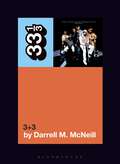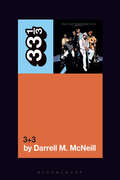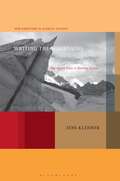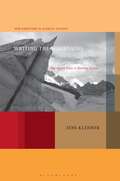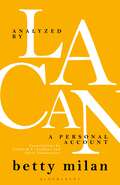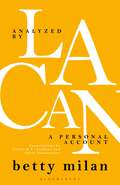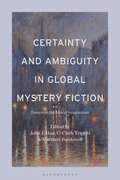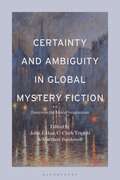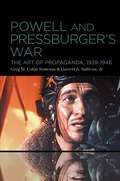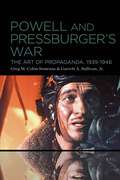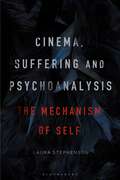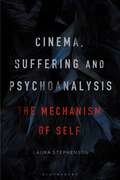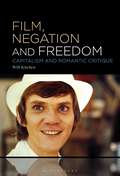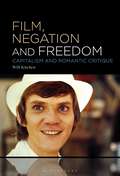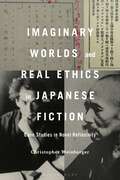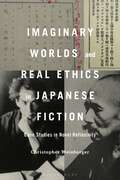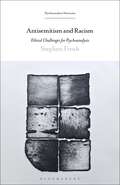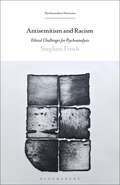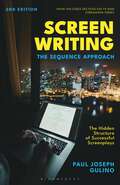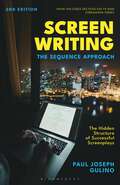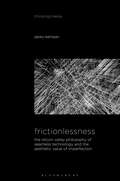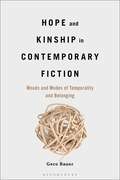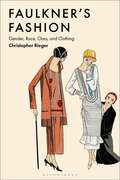- Table View
- List View
The Isley Brothers' 3+3 (33 1/3)
by Darrell M. McNeillThe Isley Brothers' 3+3, dissects The Isleys' 50-year-old undisputed masterwork, an album that firmly established their music dynasty on a global scale, as well as heralding the boldest run of genre-defiant albums of their 67-year career. The 1973 watershed was their first multiplatinum release and is significant as a rare, crossover record by a Black act that struck a chord with urban, rock, and pop consumers, despite the schisms between audiences due to bias-driven media and industry marketing.The book looks at the album from all angles: from The Isleys' early career to their influence on rock and rollers both Black and White, from the twists and turns of having national hits without national recognition, on to their decision to form T-Neck Records and the group's challenges navigating a music industry that racially codified music and hampered Black artists from universal acclaim and compensations. Finally, a summation of the decades follows The Isleys' run and its ups and downs, with a fast-forward to where the group is now after 67 years.
The Isley Brothers' 3+3 (33 1/3)
by Darrell M. McNeillThe Isley Brothers' 3+3, dissects The Isleys' 50-year-old undisputed masterwork, an album that firmly established their music dynasty on a global scale, as well as heralding the boldest run of genre-defiant albums of their 67-year career. The 1973 watershed was their first multiplatinum release and is significant as a rare, crossover record by a Black act that struck a chord with urban, rock, and pop consumers, despite the schisms between audiences due to bias-driven media and industry marketing.The book looks at the album from all angles: from The Isleys' early career to their influence on rock and rollers both Black and White, from the twists and turns of having national hits without national recognition, on to their decision to form T-Neck Records and the group's challenges navigating a music industry that racially codified music and hampered Black artists from universal acclaim and compensations. Finally, a summation of the decades follows The Isleys' run and its ups and downs, with a fast-forward to where the group is now after 67 years.
Writing the Mountains: The Alpine Form in German Fiction (New Directions in German Studies)
by Professor or Dr. Jens KlennerWriting the Mountains reconsiders the role of mountains in German language fiction from 1800 to the present and argues that in a range of texts, from E.T.A. Hoffmann's “Die Bergwerke zu Falun” (1819) to Elfriede Jelinek's Die Kinder der Toten (1995) and beyond, mountains serve as dynamic spaces of material change that generate aesthetic and narrative innovation. In contrast to dominant critical approaches to the Alpine landscape in literature, in which mountain ranges often features as passive settings, or which trace the influence of geographical and geological sciences in literary productions, this study argues for the dynamic role in literature of presumably rigid mineral structures.In German-language fiction after 1800, the counter-intuitive topology of rocky mountain ranges and unfathomable subterranean depths of the Alpine imaginary functions as a space of exception which appears to reconfirm and radically challenge the foundations of Enlightenment thought. Writing the Mountains reads the mountain range as a rigid yet permeable liminal space. Within this zone, semiotic orders are unsettled, as is the division between organic and inorganic, between the human and the other.
Writing the Mountains: The Alpine Form in German Fiction (New Directions in German Studies)
by Professor or Dr. Jens KlennerWriting the Mountains reconsiders the role of mountains in German language fiction from 1800 to the present and argues that in a range of texts, from E.T.A. Hoffmann's “Die Bergwerke zu Falun” (1819) to Elfriede Jelinek's Die Kinder der Toten (1995) and beyond, mountains serve as dynamic spaces of material change that generate aesthetic and narrative innovation. In contrast to dominant critical approaches to the Alpine landscape in literature, in which mountain ranges often features as passive settings, or which trace the influence of geographical and geological sciences in literary productions, this study argues for the dynamic role in literature of presumably rigid mineral structures.In German-language fiction after 1800, the counter-intuitive topology of rocky mountain ranges and unfathomable subterranean depths of the Alpine imaginary functions as a space of exception which appears to reconfirm and radically challenge the foundations of Enlightenment thought. Writing the Mountains reads the mountain range as a rigid yet permeable liminal space. Within this zone, semiotic orders are unsettled, as is the division between organic and inorganic, between the human and the other.
Analyzed by Lacan: A Personal Account (Psychoanalytic Horizons)
by Dr. Betty MilanAnalyzed by Lacan brings together the first English translations of Why Lacan, Betty Milan's memoir of her analysis with Lacan in the 1970s, and her play, Goodbye Doctor, inspired by her experience. Why Lacan provides a unique and valuable perspective on how Lacan worked as psychoanalyst as well as his approach to psychoanalytic theory. Milan's testimony shows that Lacan's method of working was based on the idea that the traditional way of interpreting provoked resistance. Prior to Why Lacan, Milan wrote a play, Goodbye Doctor, based on her experience as Lacan's patient. The play is structured around the sessions of Seriema with the Doctor. Through the analysis, Seriema discovers why she cannot give birth, namely, an unconscious desire to satisfy the will of her father who didn't authorize her to conceive. She ceases to be the victim of her unconscious, grasps the possibility of choosing a father for her child and thus becoming a mother. Goodbye Doctor has been adapted into a film, Adieu Lacan, by the director Richard Ledes. Analyzed by Lacan features an Introduction by Milan to both works as well as a new interview with Mari Ruti about her writing and Lacan.
Analyzed by Lacan: A Personal Account (Psychoanalytic Horizons)
by Dr. Betty MilanAnalyzed by Lacan brings together the first English translations of Why Lacan, Betty Milan's memoir of her analysis with Lacan in the 1970s, and her play, Goodbye Doctor, inspired by her experience. Why Lacan provides a unique and valuable perspective on how Lacan worked as psychoanalyst as well as his approach to psychoanalytic theory. Milan's testimony shows that Lacan's method of working was based on the idea that the traditional way of interpreting provoked resistance. Prior to Why Lacan, Milan wrote a play, Goodbye Doctor, based on her experience as Lacan's patient. The play is structured around the sessions of Seriema with the Doctor. Through the analysis, Seriema discovers why she cannot give birth, namely, an unconscious desire to satisfy the will of her father who didn't authorize her to conceive. She ceases to be the victim of her unconscious, grasps the possibility of choosing a father for her child and thus becoming a mother. Goodbye Doctor has been adapted into a film, Adieu Lacan, by the director Richard Ledes. Analyzed by Lacan features an Introduction by Milan to both works as well as a new interview with Mari Ruti about her writing and Lacan.
Certainty and Ambiguity in Global Mystery Fiction: Essays on the Moral Imagination
Mystery fiction as a genre renders moral judgments not only about detectives and criminals but also concerning the cultural structures within which these mysteries unfold.In contrast to other volumes which examine morality in crime fiction through the lenses of personal guilt and personal justice, Certainty and Ambiguity in Global Mystery Fiction analyzes the effect of moral imagination on the moral structures implicit in the genre. In recent years, public awareness has attended to the relationship between social structures and justice, and this collection centers on how personal ethics and social ethics are bound together amidst the shifting moral landscapes of mystery fiction.Contributors discuss the interplay between personal guilt and social guilt – considering morality and justice on an individual level and at a societal level – using frameworks of certainty and ambiguity. They show how individual characters in works by Agatha Christie, Gabriel García Márquez, Natsuo Kirino, F.H. Batacan, and Stephen King, among others, may view their moral standing with certainty but clash with the established mores of their culture. Featuring essays on Japanese, Filipino, Indian, and Colombian mystery fiction, as well as American and British fiction, this volume analyzes social guilt and justice across cultures, showing how individuals grapple with the certainty, and, at times, the moral ambiguity, of their respective cultures.
Certainty and Ambiguity in Global Mystery Fiction: Essays on the Moral Imagination
by John J. Han, C. Clark Triplett, and Matthew BardowellMystery fiction as a genre renders moral judgments not only about detectives and criminals but also concerning the cultural structures within which these mysteries unfold.In contrast to other volumes which examine morality in crime fiction through the lenses of personal guilt and personal justice, Certainty and Ambiguity in Global Mystery Fiction analyzes the effect of moral imagination on the moral structures implicit in the genre. In recent years, public awareness has attended to the relationship between social structures and justice, and this collection centers on how personal ethics and social ethics are bound together amidst the shifting moral landscapes of mystery fiction.Contributors discuss the interplay between personal guilt and social guilt – considering morality and justice on an individual level and at a societal level – using frameworks of certainty and ambiguity. They show how individual characters in works by Agatha Christie, Gabriel García Márquez, Natsuo Kirino, F.H. Batacan, and Stephen King, among others, may view their moral standing with certainty but clash with the established mores of their culture. Featuring essays on Japanese, Filipino, Indian, and Colombian mystery fiction, as well as American and British fiction, this volume analyzes social guilt and justice across cultures, showing how individuals grapple with the certainty, and, at times, the moral ambiguity, of their respective cultures.
Powell and Pressburger’s War: The Art of Propaganda, 1939-1946
by Professor Greg M. Semenza Garrett A. Sullivan Jr.A focused study on Michael Powell and Emeric Pressburger's cinematic contributions to the war effort, arguing for the centrality of propaganda to their work as film artists.Michael Powell and Emeric Pressburger are widely hailed as two of the greatest filmmakers in British cinema history. The release of their first movie, The Spy in Black, barely preceded the beginning of World War Two, and a number of their early masterworks, including The Life and Death of Colonel Blimp, A Canterbury Tale, and A Matter of Life and Death, were produced in the service of the war effort. Through exploring the relationship between art and propaganda, this book shows that Powell and Pressburger saw no contradiction between their aesthetic ambitions and their cinematic war work: propaganda imperatives were highly conducive to their objectives as both commercial cinema practitioners and artists.Drawing on production materials from the archives of the British Film Institute, this book charts three phases in Powell and Pressburger's wartime career: from first-time collaborators who strive to reconcile popular cinematic forms with developing notions of what constitutes effective propaganda; to accomplished, and sometimes controversial, propagandists whose movies center upon Britain's relations with its enemies and allies; to filmmakers whose responsiveness to the propaganda requirements of the late war is matched by a focus, shared by the Ministry of Information, on what the post-war future would bring.
Powell and Pressburger’s War: The Art of Propaganda, 1939-1946
by Professor Greg M. Semenza Garrett A. Sullivan Jr.A focused study on Michael Powell and Emeric Pressburger's cinematic contributions to the war effort, arguing for the centrality of propaganda to their work as film artists.Michael Powell and Emeric Pressburger are widely hailed as two of the greatest filmmakers in British cinema history. The release of their first movie, The Spy in Black, barely preceded the beginning of World War Two, and a number of their early masterworks, including The Life and Death of Colonel Blimp, A Canterbury Tale, and A Matter of Life and Death, were produced in the service of the war effort. Through exploring the relationship between art and propaganda, this book shows that Powell and Pressburger saw no contradiction between their aesthetic ambitions and their cinematic war work: propaganda imperatives were highly conducive to their objectives as both commercial cinema practitioners and artists.Drawing on production materials from the archives of the British Film Institute, this book charts three phases in Powell and Pressburger's wartime career: from first-time collaborators who strive to reconcile popular cinematic forms with developing notions of what constitutes effective propaganda; to accomplished, and sometimes controversial, propagandists whose movies center upon Britain's relations with its enemies and allies; to filmmakers whose responsiveness to the propaganda requirements of the late war is matched by a focus, shared by the Ministry of Information, on what the post-war future would bring.
Cinema, Suffering and Psychoanalysis: The Mechanism of Self
by Laura StephensonCinema, Suffering and Psychoanalysis explores psychological disorder as common to the human condition using a unique three-angled approach: psychoanalysis recognises the inherent suffering encountered by each subject due to developmental phases; psychology applies specific categorisation to how this suffering manifests; cinema depicts suffering through a combination of video and aural elements. Functioning as a culturally reflexive medium, the six feature films analysed, including Black Swan (2010) and The Machinist (2004), represent some of the most common psychological disorders and lived experiences of the contemporary era. This book enters unchartered terrain in cinema scholarship by combining clinical psychology's Diagnostic and Statistical Manual Five (DSM-V) to organise and diagnose each character, and psychoanalysis to track the origin, mechanism and affect of the psychological disorder within the narrative trajectory of each film. Lacan's theories on the infantile mirror phase, the Imaginary, and the Symbolic, Žižek's theories on the Real, the big Other and the Event, and Kristeva's theories on abjection and melancholia work in combination with the DSM's classification of symptoms to interpret six contemporary pieces of cinema. By taking into consideration that origin, mechanism, affect and symptomatology are part of an interconnected group, this book explores psychological disorder as part of the human condition, something which contributes to and informs personal identity. More specifically, this research refutes the notion that psychological disorder and psychological health exist as a binary, instead recognising that what has traditionally been pathologised, may instead be viewed as variations on human identity.
Cinema, Suffering and Psychoanalysis: The Mechanism of Self
by Laura StephensonCinema, Suffering and Psychoanalysis explores psychological disorder as common to the human condition using a unique three-angled approach: psychoanalysis recognises the inherent suffering encountered by each subject due to developmental phases; psychology applies specific categorisation to how this suffering manifests; cinema depicts suffering through a combination of video and aural elements. Functioning as a culturally reflexive medium, the six feature films analysed, including Black Swan (2010) and The Machinist (2004), represent some of the most common psychological disorders and lived experiences of the contemporary era. This book enters unchartered terrain in cinema scholarship by combining clinical psychology's Diagnostic and Statistical Manual Five (DSM-V) to organise and diagnose each character, and psychoanalysis to track the origin, mechanism and affect of the psychological disorder within the narrative trajectory of each film. Lacan's theories on the infantile mirror phase, the Imaginary, and the Symbolic, Žižek's theories on the Real, the big Other and the Event, and Kristeva's theories on abjection and melancholia work in combination with the DSM's classification of symptoms to interpret six contemporary pieces of cinema. By taking into consideration that origin, mechanism, affect and symptomatology are part of an interconnected group, this book explores psychological disorder as part of the human condition, something which contributes to and informs personal identity. More specifically, this research refutes the notion that psychological disorder and psychological health exist as a binary, instead recognising that what has traditionally been pathologised, may instead be viewed as variations on human identity.
Film, Negation and Freedom: Capitalism and Romantic Critique
by Will KitchenFilm, Negation and Freedom: Capitalism and Romantic Critique explores cinema in relation to the critical tradition in modern philosophy and its heritage in Romantic aesthetics. Synthesising a variety of discursive fields and traditions - including Early German Romanticism, Frankfurt School critical theory and the aesthetic philosophy of Jacques Rancière - Film, Negation and Freedom outlines a radical new approach to film by re-examining the work of Arthur Penn and Lindsay Anderson. A distinction between Light and Dark Romanticism is introduced as a means of interpreting cinema's relationship with capitalism, as well as dualistic concepts such as stillness and motion, passivity and activity, pain and pleasure. Film, Negation and Freedom revitalises our understanding of modern audio-visual media, as well as the aesthetic, philosophical and political conditions of Romantic subjectivity, artistic practice and spectatorship.
Film, Negation and Freedom: Capitalism and Romantic Critique
by Will KitchenFilm, Negation and Freedom: Capitalism and Romantic Critique explores cinema in relation to the critical tradition in modern philosophy and its heritage in Romantic aesthetics. Synthesising a variety of discursive fields and traditions - including Early German Romanticism, Frankfurt School critical theory and the aesthetic philosophy of Jacques Rancière - Film, Negation and Freedom outlines a radical new approach to film by re-examining the work of Arthur Penn and Lindsay Anderson. A distinction between Light and Dark Romanticism is introduced as a means of interpreting cinema's relationship with capitalism, as well as dualistic concepts such as stillness and motion, passivity and activity, pain and pleasure. Film, Negation and Freedom revitalises our understanding of modern audio-visual media, as well as the aesthetic, philosophical and political conditions of Romantic subjectivity, artistic practice and spectatorship.
Imaginary Worlds and Real Ethics in Japanese Fiction: Case Studies in Novel Reflexivity
by Professor or Dr. Christopher WeinbergerCan novels contribute to the ethical lives of readers? What responsibilities might they bear in representing others? Are we ethically accountable for how we read fiction? This study takes up modern Japanese fiction and metafiction, subjects overwhelmingly ignored by Anglophone scholarship on novel ethics, to discover pioneering answers to these and other questions. Each chapter offers new readings of major works of modern Japanese literature (1880s through 1920s) that experiment with the capacity of novel narration to involve readers in ethically freighted encounters. Christopher Weinberger shows that Mori Ogai and Akutagawa Ryunosuke help to address key issues in new ethical theories today: debates about the roles that identification and empathy play in novel ethics; concerns about the representation of “otherness” and alterity in novels; divergence between cognitive and affective theories of ethics; widespread disagreement about what novel ethics obtain in the experience of reading, the effects of reading, or the form or content of novel representation; and, finally, concerns with bias and appropriation in the study of world literature. Concluding with a jump to the present, Imaginary Worlds and Real Ethics in Japanese Fiction puts on display a startling continuity between the methods of Japan's modern novel progenitors and those of novelists at the forefront of global literature today, especially Haruki Murakami. Ultimately, this book models an original approach to ethical criticism while demonstrating the relevance of modern Japanese fiction for rethinking contemporary theories of the novel.
Imaginary Worlds and Real Ethics in Japanese Fiction: Case Studies in Novel Reflexivity
by Professor or Dr. Christopher WeinbergerCan novels contribute to the ethical lives of readers? What responsibilities might they bear in representing others? Are we ethically accountable for how we read fiction? This study takes up modern Japanese fiction and metafiction, subjects overwhelmingly ignored by Anglophone scholarship on novel ethics, to discover pioneering answers to these and other questions. Each chapter offers new readings of major works of modern Japanese literature (1880s through 1920s) that experiment with the capacity of novel narration to involve readers in ethically freighted encounters. Christopher Weinberger shows that Mori Ogai and Akutagawa Ryunosuke help to address key issues in new ethical theories today: debates about the roles that identification and empathy play in novel ethics; concerns about the representation of “otherness” and alterity in novels; divergence between cognitive and affective theories of ethics; widespread disagreement about what novel ethics obtain in the experience of reading, the effects of reading, or the form or content of novel representation; and, finally, concerns with bias and appropriation in the study of world literature. Concluding with a jump to the present, Imaginary Worlds and Real Ethics in Japanese Fiction puts on display a startling continuity between the methods of Japan's modern novel progenitors and those of novelists at the forefront of global literature today, especially Haruki Murakami. Ultimately, this book models an original approach to ethical criticism while demonstrating the relevance of modern Japanese fiction for rethinking contemporary theories of the novel.
Antisemitism and Racism: Ethical Challenges for Psychoanalysis (Psychoanalytic Horizons)
by Stephen FroshPsychoanalysis has not had a comfortable history in relation to "race" and racism, despite its origins in the Jewish lives of Freud and its other first-generation progenitors and the insistent pressure of antisemitism upon it. Indeed, the failure to fully address racism is a running sore in the psychoanalytic movement. This has begun to be remedied in recent years, but it is still the case that psychoanalysis struggles to incorporate antiracist perspectives and that this might be a reason why it has engaged relatively poorly with Black communities. Psychoanalysis may have been a "Jewish science" in a positive sense, but it has not fully leveraged this to become a truly antiracist one.In Antisemitism and Racism, Stephen Frosh, a leading figure in psychoanalytic studies, provides a psychoanalytically-informed examination of the relations between antisemitism and antiblack racism. Frosh's starting point is a claim that the Jewish origins and implications of psychoanalysis fuel its capacity to interrogate racism of all kinds. Indeed, the shared experience of exposure to different kinds of racism raises prospects for renewed alliances between Jewish and Black communities. Antisemitism and Racism ends with a chapter that asks psychoanalysis itself to respond to some of the challenges emerging from the Black Lives Matter and decolonial movements.At a time when division and prejudice are on the rise to an alarming degree, it is imperative that we examine, understand, and discuss the psychological roots of racism.
Antisemitism and Racism: Ethical Challenges for Psychoanalysis (Psychoanalytic Horizons)
by Stephen FroshPsychoanalysis has not had a comfortable history in relation to "race" and racism, despite its origins in the Jewish lives of Freud and its other first-generation progenitors and the insistent pressure of antisemitism upon it. Indeed, the failure to fully address racism is a running sore in the psychoanalytic movement. This has begun to be remedied in recent years, but it is still the case that psychoanalysis struggles to incorporate antiracist perspectives and that this might be a reason why it has engaged relatively poorly with Black communities. Psychoanalysis may have been a "Jewish science" in a positive sense, but it has not fully leveraged this to become a truly antiracist one.In Antisemitism and Racism, Stephen Frosh, a leading figure in psychoanalytic studies, provides a psychoanalytically-informed examination of the relations between antisemitism and antiblack racism. Frosh's starting point is a claim that the Jewish origins and implications of psychoanalysis fuel its capacity to interrogate racism of all kinds. Indeed, the shared experience of exposure to different kinds of racism raises prospects for renewed alliances between Jewish and Black communities. Antisemitism and Racism ends with a chapter that asks psychoanalysis itself to respond to some of the challenges emerging from the Black Lives Matter and decolonial movements.At a time when division and prejudice are on the rise to an alarming degree, it is imperative that we examine, understand, and discuss the psychological roots of racism.
Screenwriting: The Sequence Approach
by Professor Paul Joseph GulinoA substantial update of the previous edition, Screenwriting: The Sequence Approach deconstructs recent feature films and offers a new section analysing popular television series.A proven screenwriting method in emotionally engaging an audience, the sequence approach emphasises the underlying motives of each story plot to better convey its relation to the work as a whole. In this expanded second edition, Paul Gulino includes analyses of recent noteworthy films and serial dramas, such as Parasite, Barry and Breaking Bad, with an eye to how they manage audience attention, convey vital information and deliver their emotional payloads. The aim of the book is to help writers move readily from the feature film to the serial form, mastering both. It is perfect for both beginning writers and those with experience in the feature screenplay form.
Screenwriting: The Sequence Approach
by Professor Paul Joseph GulinoA substantial update of the previous edition, Screenwriting: The Sequence Approach deconstructs recent feature films and offers a new section analysing popular television series.A proven screenwriting method in emotionally engaging an audience, the sequence approach emphasises the underlying motives of each story plot to better convey its relation to the work as a whole. In this expanded second edition, Paul Gulino includes analyses of recent noteworthy films and serial dramas, such as Parasite, Barry and Breaking Bad, with an eye to how they manage audience attention, convey vital information and deliver their emotional payloads. The aim of the book is to help writers move readily from the feature film to the serial form, mastering both. It is perfect for both beginning writers and those with experience in the feature screenplay form.
Frictionlessness: The Silicon Valley Philosophy of Seamless Technology and the Aesthetic Value of Imperfection (Thinking Media)
by Jakko KemperFrictionlessness provides an examination of the environmentally destructive digital design philosophy of "frictionlessness" and the critical significance of a technological aesthetic of imperfection.If there is one thing that defines digital consumer technologies today, it is that they are designed to feel frictionless. From smart technologies to cloud computing, from from one-click shopping to the promise of seamless streaming-digital technology is framed to host ever-faster operations while receding increasingly into the background of perception. The environmental costs of this fetishization of frictionlessness are enormous and unevenly distributed; the frictionless experience of the end user tends to be supported by opaque networks of exploited labor and extracted resources that disproportionately impact the Global South. This situation marks an urgent need for alternate, less destructive aesthetic relations to technology. As such, this book examines imperfection, as an aesthetic concept that highlights existential conditions of finitude and fragility, as a particularly powerful counterweight to the dominant digital design philosophy of frictionlessness.While frictionlessness aims to draw the user's perception away from the exploitative and destructive conditions of digital production, imperfection forms an aesthetic source of friction that alerts users to the fragile nature of technology and the finite resources on which it relies. These arguments are elaborated through a close reading of three technological objects-a video game that was programmed to expire, an audiovisual performance that laments the fate of disused technology and a collection of music albums that dramatize a techno-cultural logic of relentless consumerism. Together, these case studies underline the value of technological aesthetics of imperfection and point to the need for a renewed ethics of care in relation to technology.
Frictionlessness: The Silicon Valley Philosophy of Seamless Technology and the Aesthetic Value of Imperfection (Thinking Media)
by Jakko KemperFrictionlessness provides an examination of the environmentally destructive digital design philosophy of "frictionlessness" and the critical significance of a technological aesthetic of imperfection.If there is one thing that defines digital consumer technologies today, it is that they are designed to feel frictionless. From smart technologies to cloud computing, from from one-click shopping to the promise of seamless streaming-digital technology is framed to host ever-faster operations while receding increasingly into the background of perception. The environmental costs of this fetishization of frictionlessness are enormous and unevenly distributed; the frictionless experience of the end user tends to be supported by opaque networks of exploited labor and extracted resources that disproportionately impact the Global South. This situation marks an urgent need for alternate, less destructive aesthetic relations to technology. As such, this book examines imperfection, as an aesthetic concept that highlights existential conditions of finitude and fragility, as a particularly powerful counterweight to the dominant digital design philosophy of frictionlessness.While frictionlessness aims to draw the user's perception away from the exploitative and destructive conditions of digital production, imperfection forms an aesthetic source of friction that alerts users to the fragile nature of technology and the finite resources on which it relies. These arguments are elaborated through a close reading of three technological objects-a video game that was programmed to expire, an audiovisual performance that laments the fate of disused technology and a collection of music albums that dramatize a techno-cultural logic of relentless consumerism. Together, these case studies underline the value of technological aesthetics of imperfection and point to the need for a renewed ethics of care in relation to technology.
Hope and Kinship in Contemporary Fiction: Moods and Modes of Temporality and Belonging
by Dr. Gero BauerExplores the emphasis that contemporary novels, films and television series place on the present, arguing that hope emerges from the potentiality of the here and now, rather than the future, and as intimately entangled with negotiations of structures of belonging.Taking its cue from an understanding of hope as connoting an organizing temporality, one which is often presumed to be projecting into a future, Hope and Kinship in Contemporary Fiction challenges this understanding, arguing that hope emerges in practices of relationality in the present, disentangling hope from a necessary correlation with futurity. Through close readings of contemporary works, including The Road, The Walking Dead, Cloud Atlas, Sense8, The People in the Trees and A Little Life, Gero Bauer investigates how these texts explore structures of kinship as creative and affective practices of belonging and care that claim spaces beyond the heterosexual, reproductive nuclear family. In this context, fictional figurations of the child – often considered the bearer of the future – are of particular interest. Through these interventions into definitions of and reflections on fictional manifestations of hope and kinship, Bauer's analyses intersect with queer theory, new materialism and postcritical approaches to literature and cultural studies, moving towards counterintuitively hopeful readings of the present moment.
Hope and Kinship in Contemporary Fiction: Moods and Modes of Temporality and Belonging
by Dr. Gero BauerExplores the emphasis that contemporary novels, films and television series place on the present, arguing that hope emerges from the potentiality of the here and now, rather than the future, and as intimately entangled with negotiations of structures of belonging.Taking its cue from an understanding of hope as connoting an organizing temporality, one which is often presumed to be projecting into a future, Hope and Kinship in Contemporary Fiction challenges this understanding, arguing that hope emerges in practices of relationality in the present, disentangling hope from a necessary correlation with futurity. Through close readings of contemporary works, including The Road, The Walking Dead, Cloud Atlas, Sense8, The People in the Trees and A Little Life, Gero Bauer investigates how these texts explore structures of kinship as creative and affective practices of belonging and care that claim spaces beyond the heterosexual, reproductive nuclear family. In this context, fictional figurations of the child – often considered the bearer of the future – are of particular interest. Through these interventions into definitions of and reflections on fictional manifestations of hope and kinship, Bauer's analyses intersect with queer theory, new materialism and postcritical approaches to literature and cultural studies, moving towards counterintuitively hopeful readings of the present moment.
Faulkner’s Fashion: Gender, Race, Class, and Clothing
by Professor Christopher RiegerThe first book-length study of clothing and dress across William Faulkner's novels and short stories.Clothing is one of the most important and pervasive material items throughout William Faulkner's fiction. Faulkner's Fashion analyzes the writer's use of clothing from a variety of critical approaches, considering how clothing and dress intersect with race, class, and gender across Faulkner's works. It also considers clothes as material objects, using Thing Theory and Object Oriented Ontology to illuminate the role clothing plays as an object in conjunction with its multiple layers of symbolic meaning to both the wearer and the observer. Faulkner's Fashion reveals how much attention Faulkner pays to garments and fashion in his own life and in his fiction, arguing that dress is often a means of characterization for Faulkner, while it also connects his narrative representations of gender, sexuality, class, poverty, race, and modernity.
